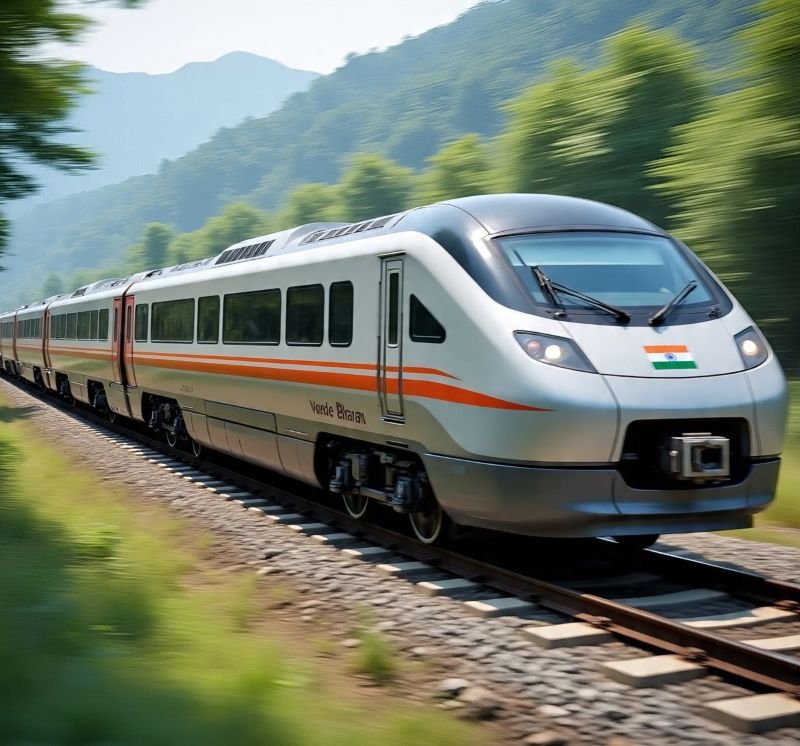Spiritual Travel
Thomas Cook India & SOTC Travel Expand Spiritual Tourism Focus – Moneycontrol

Spiritual Travel
Thomas Cook India & SOTC Travel deepen focus on spiritual tourism

Thomas Cook (India) Limited, the omnichannel travel services company, and its Group Company, SOTC Travel, have announced the expansion of their spiritual portfolio across key pilgrimage destinations in India and the subcontinent, catering to both group and customized tours.
Traditionally, Indian spiritual pilgrimages have often been perceived as challenging and uncomfortable —marked by long journeys, limited connectivity and infrastructure. Recognising these challenges, Thomas Cook India & SOTC Travel have designed tours by introducing aerial darshans, guided tours, VIP access for darshans and more.
Rooted in the philosophy that ‘India is a Pilgrimage’, the tours have been designed to cater to the spiritual aspirations of a broad spectrum of travellers – from GenS (seniors) who value time-honoured traditions, multi-generational families to millennials and GenZ travellers seeking spirituality as a path to mindfulness, wellness and cultural discovery—seamlessly blending sacred journeys with unique local experiences.
Key highlights:
- A curated portfolio of 11 iconic pilgrimage sites across India’s vast geography, covering temples, shrines and sacred rivers across India and the Indian subcontinent
- Certified local tour experts who offer deep insights into the history and cultural significance of each site, while facilitating seamless access and VIP/escorted darshans at key pilgrimage locations
- Special aartis, pujas and spiritual rituals conducted with accompanying pandits for a personalized spiritual experience
- Pure Vegetarian/Jain meal options to align with travellers’ religious and dietary preferences
- Premium aerial darshans (via helicopters) at select pilgrimage sites for faster, more comfortable access to remote & high-altitude spiritual circuits
Top group tour pilgrimage circuits
- Char Dham Yatra (Yamunotri, Gangotri, Kedarnath, Badrinath) — The Himalayan spiritual circuit of great reverence via aerial darshans
- Kailash Mansarovar Yatra — A sacred journey to the abode of Lord Shiva via aerial darshans
- Kashi Prayagraj Ayodhya Bodh Gaya Yatra — Sacred sites along the river Ganga, steeped in mythology and history, rites and rituals.
- Dwarka Somnath Yatra — Gujarat’s twin pilgrimages celebrating Lord Krishna and Lord Shiva
- Tirupati to Trivandrum — South India’s iconic temple circuits for spiritual fulfilment
- Haridwar Rishikesh Yatra — Spiritual wellness on the banks of the Ganges
- Ujjain Omkareshwar to Bhimashankar Grishneshwar Yatra — sacred Shiva circuits in Malwa region of Madhya Pradesh to Maharashtra
- Kashi to Kathmandu To Muktinath To Janakpur – Bharat Nepāl Mahayātrā covering spiritual landmarks across both nations
- Puri Jagannath Yatra – a cornerstone of India’s Char Dham circuit and key spiritual landmark in Odisha
- Ramayan Yatras Covering India, Sri Lanka and Nepal
- Short Getaways to Vaishno Devi, Amritsar, Shirdi, Rishikesh, Mathura, Velankanni, etc.
In addition, we also offer a wide range of customised pilgrimage tours tailored to individual preferences and requirements.
Rajeev Kale, President & Country Head, Holidays, MICE, Visa – Thomas Cook (India) Limited said, “Spiritual tourism is no longer limited to a season or festival – it has become a year-round experience.
“India’s vast spiritual landscape offers travellers an unparalleled opportunity to engage with its deep-rooted spiritual ethos, while also immersing themselves in the country’s rich heritage and culture.
“With an intent is to inspire not just seniors and families but also young India’s millennials, working professionals and groups of friends, we have expanded our spiritual tours at key spiritual sites coupled with unique local experiences like river-rafting and kayaking in Rishikesh, paragliding in Vaishno Devi, cuisine trails in Varanasi and Haridwar.
“This initiative strengthens our domestic and spiritual travel segment, offering travellers a meaningful way to connect with the soul of India,” Kale added.
S.D. Nandakumar, President & Country Head – Holidays and Corporate Tours, SOTC Travel Limited said, “We are witnessing strong demand for our Darshans portfolio, with destinations like Char Dham and Kailash Mansarovar ranking among the most sought-after pilgrimage sites.
“There is also significant interest in Ayodhya, Dwarka, Vaishno Devi, Tirupati, Rishikesh, Haridwar, and Ujjain. This is gaining momentum not just from India’s metro cities, but also from regional mini-metros and tier 2–3 cities.
“To enhance comfort and convenience, we have introduced premium aerial darshans to select sacred locations via helicopters.
“Furthermore, address the challenges of spiritual travel in India, we’ve curated end-to-end tours that offer our customers assurance and ease—covering transport, accommodation, VIP/escorted darshans, guides and more.
“Our meaningful TravSure assurance programme covers select pilgrimage sites ensuring a safe, smooth and hassle-free experience with comprehensive travel insurance and on-ground support,” Nandakumar added.
Spiritual Travel
Thomas Cook India & SOTC Travel deepens focus on Spiritual Tourism Leveraging strong demand with a diverse range of pilgrimages across India & the Subcontinent

Mumbai, August 7, 2025: Thomas Cook (India) Limited – India’s leading omnichannel travel services company, and its Group Company, SOTC Travel, have announced the expansion of their spiritual portfolio across key pilgrimage destinations in India and the subcontinent, catering to both group and customized tours.
Traditionally, Indian spiritual pilgrimages have often been perceived as challenging and uncomfortable —marked by long journeys, limited connectivity and infrastructure. Recognising these challenges, Thomas Cook India & SOTC Travel have designed tours by introducing aerial darshans, guided tours, VIP access for darshans and more.
Rooted in the philosophy that ‘India is a Pilgrimage’, the tours have been designed to cater to the spiritual aspirations of a broad spectrum of travellers – from GenS (seniors) who value time-honoured traditions, multi-generational families to millennials and GenZ travellers seeking spirituality as a path to mindfulness, wellness and cultural discovery—seamlessly blending sacred journeys with unique local experiences.
Key highlights:
· A curated portfolio of 11 iconic pilgrimage sites across India’s vast geography, covering temples, shrines and sacred rivers across India and the Indian subcontinent
· Certified local tour experts who offer deep insights into the history and cultural significance of each site, while facilitating seamless access and VIP/escorted darshans at key pilgrimage locations
· Special aartis, pujas and spiritual rituals conducted with accompanying pandits for a personalized spiritual experience
· Pure Vegetarian/Jain meal options to align with travellers’ religious and dietary preferences
· Premium aerial darshans (via helicopters) at select pilgrimage sites for faster, more comfortable access to remote & high-altitude spiritual circuits
Top group tour pilgrimage circuits
· Char Dham Yatra (Yamunotri, Gangotri, Kedarnath, Badrinath) — The Himalayan spiritual circuit of great reverence via aerial darshans
· Kailash Mansarovar Yatra — A sacred journey to the abode of Lord Shiva via aerial darshans
· Kashi Prayagraj Ayodhya Bodh Gaya Yatra — Sacred sites along the river Ganga, steeped in mythology and history, rites and rituals.
· Dwarka Somnath Yatra — Gujarat’s twin pilgrimages celebrating Lord Krishna and Lord Shiva
· Tirupati to Trivandrum — South India’s iconic temple circuits for spiritual fulfilment
· Haridwar Rishikesh Yatra — Spiritual wellness on the banks of the Ganges
· Ujjain Omkareshwar to Bhimashankar Grishneshwar Yatra — sacred Shiva circuits in Malwa region of Madhya Pradesh to Maharashtra
· Kashi to Kathmandu To Muktinath To Janakpur – Bharat Nepāl Mahayātrā covering spiritual landmarks across both nations
· Puri Jagannath Yatra – a cornerstone of India’s Char Dham circuit and key spiritual landmark in Odisha
· Ramayan Yatras Covering India, Sri Lanka and Nepal
· Short Getaways to Vaishno Devi, Amritsar, Shirdi, Rishikesh, Mathura, Velankanni, etc.
In addition, we also offer a wide range of customised pilgrimage tours tailored to individual preferences and requirements.
Mr. Rajeev Kale, President & Country Head, Holidays, MICE, Visa – Thomas Cook (India) Limited said, “Spiritual tourism is no longer limited to a season or festival – it has become a year-round experience. India’s vast spiritual landscape offers travellers an unparalleled opportunity to engage with its deep-rooted spiritual ethos, while also immersing themselves in the country’s rich heritage and culture. With an intent is to inspire not just seniors and families but also young India’s millennials, working professionals and groups of friends, we have expanded our spiritual tours at key spiritual sites coupled with unique local experiences like river-rafting and kayaking in Rishikesh, paragliding in Vaishno Devi, cuisine trails in Varanasi and Haridwar. This initiative strengthens our domestic and spiritual travel segment, offering travellers a meaningful way to connect with the soul of India.”
Mr. S.D. Nandakumar, President & Country Head – Holidays and Corporate Tours, SOTC Travel Limited said, “We are witnessing strong demand for our Darshans portfolio, with destinations like Char Dham and Kailash Mansarovar ranking among the most sought-after pilgrimage sites. There is also significant interest in Ayodhya, Dwarka, Vaishno Devi, Tirupati, Rishikesh, Haridwar, and Ujjain. This is gaining momentum not just from India’s metro cities, but also from regional mini-metros and tier 2–3 cities.
To enhance comfort and convenience, we have introduced premium aerial darshans to select sacred locations via helicopters. Furthermore, address the challenges of spiritual travel in India, we’ve curated end-to-end tours that offer our customers assurance and ease—covering transport, accommodation, VIP/escorted darshans, guides and more. Our meaningful TravSure assurance programme covers select pilgrimage sites ensuring a safe, smooth and hassle-free experience with comprehensive travel insurance and on-ground support.”
For further details, click here: Thomas Cook | SOTC
Spiritual Travel
Katra–Amritsar Vande Bharat Express Poised to Revolutionize Northern Rail Travel through Jammu Tawi, Jalandhar City, Beas, and Pathankot Cantt, Catalyzing Growth in Pilgrimage, Tourism, and Regional Connectivity Across India

Published on
August 7, 2025 |
By: TTW News Desk
A New Dawn in Northern India’s Rail Journey
It was described as a transformative moment for rail travel across northern India, with plans underway to launch the much‑anticipated Katra–Amritsar Vande Bharat Express on August 11. The service was portrayed as a striking innovation in the region’s rail infrastructure, expected to shrink travel time between Shri Mata Vaishno Devi Katra and Amritsar from about 6–7 hours to only 4.5 hours. It was emphasized that this move formed part of a broader strategy to elevate rail connectivity, focusing on speed, safety, and comfort for passengers.
The account noted that this train’s commencement, together with launches of two other Vande Bharat routes, would be inaugurated via virtual ceremony on August 10—a symbolic gesture reinforcing a national shift toward modern, efficient transportation.
Navigating the Route: Timings, Stops, and Maintenance
It was conveyed that the new eight‑coach express had been slated to operate six days a week, with services paused every Tuesday for maintenance, which would take place at the Sahibabad facility—a site equipped to uphold high-speed rail standards.
The outbound leg was scheduled to begin at 6:40 AM from Shri Mata Vaishno Devi Katra, reaching Amritsar at around 12:20 PM. En route, it would pause at key stations including Jammu Tawi, Jalandhar City, and Beas, marking them as essential commuter and pilgrim connectivity nodes.
On the return path, departure from Amritsar was to occur around 4:25 PM, aiming to reach Katra by 10:00 PM. The stops along the way were set to include Beas, Jalandhar City, Pathankot Cantt, and Jammu Tawi. These were noted as carefully chosen to service both daily travelers and pilgrim groups, especially those heading to revered destinations like Vaishno Devi and Amritsar, home to the Golden Temple.
Fare and Accessibility: Quality Meets Affordability
The article outlined that tickets were expected to be priced between ₹1,000 and ₹1,100. It was suggested that this range struck a balance—offering a premium travel experience without being overly expensive. The fare was depicted as accessible enough to appeal to a wide demographic—travelers seeking comfort, speed, and value.
A quick summary read:
- Estimated Fare: ₹1,000–₹1,100
- Service Frequency: Six days a week (no service on Tuesdays)
The pricing model was implied to offer passengers a chance to upgrade from conventional services without stretching their budgets—a strategic pricing balance between affordability and sophistication.
Pilgrimage and Global Tourism: Opening Paths to Spiritual and Cultural Journeys
It was emphasized that this train’s launch would likely redefine religious tourism in northern India. With millions of pilgrims visiting Shri Mata Vaishno Devi Katra annually, the faster rail link was said to offer them the luxury of shorter, more comfortable trips—less travel fatigue and greater accessibility.
Simultaneously, Amritsar, famed for its cultural and spiritual legacy, was expected to see an uptick in visitors—both domestic and international—thanks to improved access. The Golden Temple, as a major draw, would benefit from more travelers arriving conveniently, which, in turn, was expected to fuel growth in local businesses, hospitality, and the wider economy.
These effects were cast as multifaceted:
- Faster reach to Vaishno Devi Temple
- Heightened tourism in Amritsar
- Streamlined travel for foreign visitors
- A symbol of modern rail progress
The narrative stressed that the train wouldn’t merely move people—it would stimulate economic activity, encourage investment in lodging and services, and shift how travelers engage with India’s spiritual and cultural routes.
Part of a Larger Vision: Upcoming Routes Across the Nation
It was clarified that this addition was part of a broader rail expansion. On August 10, launches were planned for two other routes: Belagavi–Bengaluru and Ajni (Nagpur)–Pune. Though geographically dispersed, these routes were portrayed as components of a unified strategy: developing fast, reliable, and technologically advanced rail corridors.
Observers framed this development as evidence of a long‑term vision toward building interconnected, high-speed rails that drive regional growth and nationally spurred cohesion. It was seen as a deliberate push toward accessible and intelligent infrastructure capable of covering vast distances with efficiency.
Transformation in Travel Behavior and Industry Response
The new train was credited with igniting a shift in the broader travel ecosystem. Shortened travel durations were expected to afford travelers more flexibility, enabling quick jaunts, especially over weekends or during festivals. Such ease was seen as a potential catalyst for increased short-term tourism, making spiritual and cultural sites more reachable than ever.
The anticipated ripple effects included:
- A rise in weekend tourism
- Enhanced access to small towns
- Greater demand for group travel packages
- A push toward sustainable transport—fewer cars and buses on the road
It was noted that commercial operators would need to evolve—offering innovations like automated check-ins, tailored itineraries, and better coordination with buses, taxis, or flights. These changes, it was suggested, weren’t just about speed but about crafting a holistic passenger experience attuned to modern travelers who value time, convenience, and comfort.
Beginning of a New Era: Rail Travel Redefined in Northern India
Finally, it was reflected that the Katra–Amritsar Vande Bharat Express stood for more than just reduced journey times—it signaled a promise of enhanced regional linkage, economic uplift, and tourism expansion. For both domestic visitors and international guests, this train was poised to revolutionize travel to holy and cultural sites.
By forging a quick and modern connection between two spiritually significant destinations, the authorities were credited with setting a new standard for what train travel in India should represent—faster, safer, cleaner, and more comfortable.
This development was framed not merely as infrastructure progression but as a forward-looking vision where India’s railways might become a global exemplar of efficiency, inclusiveness, and innovation. In that light, the journey between Katra and Amritsar had become not only shorter but smarter—and symbolic of the next generation of rail travel.
-

 Brand Stories2 weeks ago
Brand Stories2 weeks agoBloom Hotels: A Modern Vision of Hospitality Redefining Travel
-

 Brand Stories2 weeks ago
Brand Stories2 weeks agoCheQin.ai sets a new standard for hotel booking with its AI capabilities: empowering travellers to bargain, choose the best, and book with clarity.
-

 Destinations & Things To Do3 weeks ago
Destinations & Things To Do3 weeks agoUntouched Destinations: Stunning Hidden Gems You Must Visit
-

 Destinations & Things To Do2 weeks ago
Destinations & Things To Do2 weeks agoThis Hidden Beach in India Glows at Night-But Only in One Secret Season
-

 AI in Travel3 weeks ago
AI in Travel3 weeks agoAI Travel Revolution: Must-Have Guide to the Best Experience
-

 Brand Stories1 month ago
Brand Stories1 month agoVoice AI Startup ElevenLabs Plans to Add Hubs Around the World
-

 Brand Stories4 weeks ago
Brand Stories4 weeks agoHow Elon Musk’s rogue Grok chatbot became a cautionary AI tale
-

 Brand Stories2 weeks ago
Brand Stories2 weeks agoContactless Hospitality: Why Remote Management Technology Is Key to Seamless Guest Experiences
-

 Asia Travel Pulse1 month ago
Asia Travel Pulse1 month agoLooking For Adventure In Asia? Here Are 7 Epic Destinations You Need To Experience At Least Once – Zee News
-

 AI in Travel1 month ago
AI in Travel1 month ago‘Will AI take my job?’ A trip to a Beijing fortune-telling bar to see what lies ahead | China











You must be logged in to post a comment Login